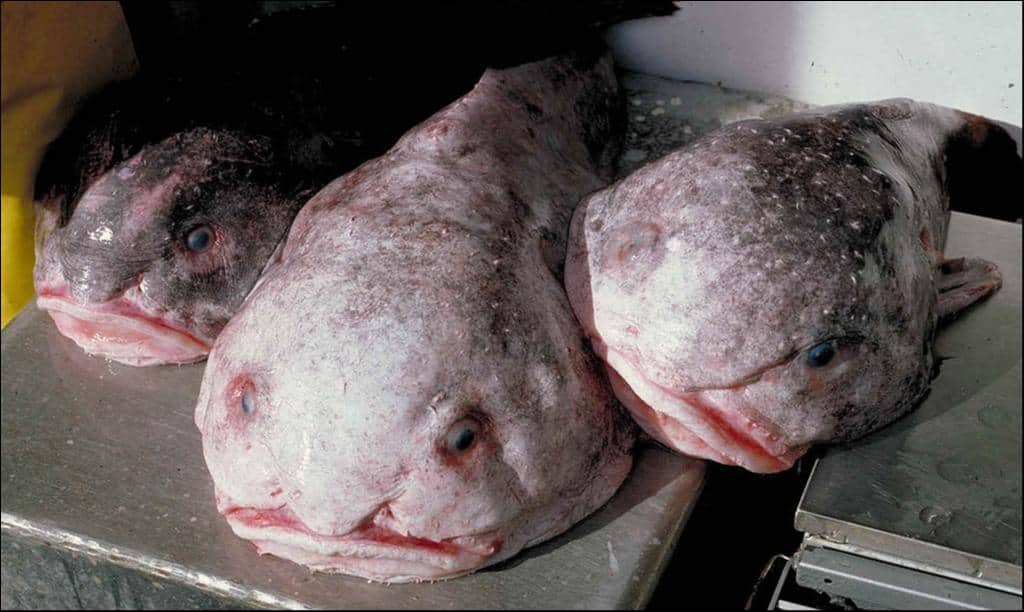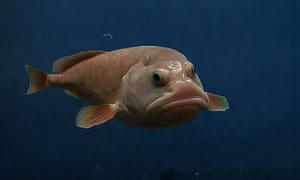Blobfish are deep-sea fish found in the waters off the coast of Australia and Tasmania. They usually grow to be about one foot long. However, some have gotten a bit bigger! If you want to understand why these fish look like blobs and how they really look underwater, this article’s for you!
What do blobfish look like underwater?
Read on to learn the truth now.
What Do Blobfish Look Like Underwater?

Blobfish look like normal fish in their natural environment.
©World-Wide-Photography/Shutterstock.com
What do blobfish look like underwater? Blobfish look like normal fish in their natural environment. They have large bulbous heads and massive jaws. Their tails also taper to make them appear more like a tadpole than fish. Their skin is loose-fitting due to the water pressure.
The fish gets its name from its unique body shape, reminiscent of a blobby blob of jelly. But they aren’t such big blobs in the ocean depths. Blobfish take advantage of the water pressure deep underwater to keep their figure. Intense water pressure helps form their tadpole-like shape. This is all thanks to their deep-dwelling lifestyle.
Do Blobfish Have Muscles or Bones?
Blobfish don’t have muscles or bones. They don’t even have teeth! Instead of bones, these fish have a soft structure. Some report the fish as having soft bones, but this isn’t true. Their structure is soft and completely bone-free.
Not having muscles would be a problem for fish that need to swim around. But blobfish doesn’t mind being couch potatoes.
They’re lazy fish that don’t spend a lot of energy. Instead of hunting, they wait for whatever snacks come their way. Some of the blobfish’s favorite foods include small crustaceans found on the ocean floor.
What Do Blobfish Look Like Out of the Water?

Out of the water, a blobfish’s body becomes gelatinous, blobby, and flabby.
©lacking author information / public domain – License
Out of the water, a blobfish’s body becomes gelatinous, blobby, and flabby. This is because there’s no water pressure to hold the fish together. A blobfish’s eyes, mouth, and nose become more prominent, making it look like a blobby alien. It’s common to see a picture of a blobfish with an oversized nose. But these photos lie! Blobfish don’t have big noses at all.
Do Blobfish Have Normal Noses?
In photos, blobfish appear to have a big nose. But this is an effect of fisherman’s nets pressing against their jelly-like body. As their form changes closer to the surface, their thick gelatinous skin becomes thin and sees through. Without water pressure, blobfish won’t look like their natural form. This is why the fish are much cuter underwater!
What Do Blobfish Babies Look Like Underwater?
Have you ever seen a blobfish baby? They’re so cute! Baby blobfish emerge from their egg nests, looking like miniature versions of the adults. The young animals have big heads, bulbous jaws, and tapered tails. Even as babies, their body design helps them float around easily in deep water without using powerful strokes or muscles.
Baby Blobfish Above Water
If you pull a baby blobfish out of the water, it’ll deflate. What was once a cute tadpole shape will turn into a melted blob. Like their parents, baby blobfish need the pressure of the deep ocean to keep their form. That’s one of the reasons why you could never own a blobfish as a pet. They couldn’t survive away from their natural deep water habitat.
Blobfish Natural Habitat

Blobfish live deep in the ocean.
©NOAA/MBARI / public domain – License
Blobfish live deep in the ocean, and we mean really deep. You won’t find any of these fish until you go at least 1600 feet deep. These fish need the deepest of waters if they want to keep their form. Some of these deep-dwelling jellies even live at depths of 4,000 feet. The pressure there is so intense there aren’t any predators around to eat the blobfish.
Blobfish Bias: Deep Sea Fears
Blobfish aren’t scary or ugly, but some people shy away from caring about them. Why? Research suggests that people may appear to not care when the truth is they’re afraid. Their apparent apathy is a subconscious fear of the deep ocean. Stories about sea monsters still lurk in many of our minds. Thankfully, as we learn more about deep-dwelling creatures, we can raise public awareness for conservation efforts! Blobfish aren’t scary; they’re fantastic creatures worth saving.
How Many Blobfish Still Exist?
There are only around 420 blobfish remaining globally. These interesting-looking creatures used to have a population that may have numbered in the hundreds of thousands, but issues related to their habitat and unintentional captures are now jeopardizing the survival of their species.
Blobfish are typically located in dim, frigid environments at the deep ocean floors of the Atlantic, Indian, and Pacific oceans, dwelling between depths of 1,970 to 3,940 feet. That means it is rare to spot one let alone bring one to the surface.
The majority of known marine species inhabit the uppermost layer of the ocean, staying above approximately 650 feet, where there is still natural light.
How Do Blobfish Survive a Harsh Habitat?

Blobfish have no known predators but could become threatened by destructive human activities.
©Alan Riverstone McCulloch (1885-1925) / public domain – License
These flabby fish have no known predators but could become threatened by destructive human activities. Activities such as deep-sea fishing or bottom trawling endanger the blobfish populations. Trawling is a deep-sea fishing method that involves dragging weights along floor surfaces near underwater sediments. These areas are where nutrients accumulate, making them prime feeding grounds for blobfish. When fisherman drops their nets, they might accidentally scoop up a blobfish.
How Do Blobfish Survive Extreme Water Pressure?
How do the blobfish survive extreme water pressure? They have specially designed bodies.
Unlike other fish that use gas-filled sacs for balance, blobfish don’t have swim bladders. If they did, it would implode if it were filled with air. Instead, their body is made up mostly of jelly-like flesh. Their jelly composition helps them withstand high pressure since water has less density than air.
How Do Blobfish Reproduce?
Another advantage the blobfish has is its incredible reproductive skills. The reproduction of the blobfish is a unique phenomenon. They generate large clutches, laying between 100-1000 eggs at once in nests which they guard closely while parents stay nearby to take care.
Final Thoughts: What Do Blobfish Look Like Underwater?
What do blobfish look like underwater? Now you know! Blobfish may look blobby on land, but in water, they have a normal – albeit odd-looking – shape. Even as babies, blobfish take on the same shape as their parents.
In their natural environment, blobfish look like oversized tadpoles with big eyes and huge mouths. Even though they don’t have scales, these deep-sea dwellers have a special gelatinous skin that helps them survive.
Their jelly-like skin also helps them maintain their form in the deep-sea depths. These creatures are expert survivalists. Some blobfish wind up living over 100 years!
So next time you hear someone say that blobfish look blobby, you can correct them! Blobfish aren’t blobby – they’re pretty cute. Keep building your expertise about these awesome fish by checking out the articles below!
The photo featured at the top of this post is © World-Wide-Photography/Shutterstock.com
Sources
- Penn State (1970) sites.psu.edu/sinkorswim/tag/blobfish/
- Island Bay Marine Education (1970) octopus.org.nz/content/blobfish-facts
- American Association for Advancement of Science (1970) aaas.org/news/weird-wonderful-creatures-blobfish
Thank you for reading! Have some feedback for us? Contact the AZ Animals editorial team.




